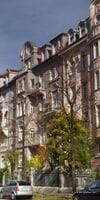Bogenhausen is an urban district number 13 in Munich.
The Bogenhausen district is located on the east side of the Isar River.
Bogenhausen has long been a suburb and a place which housed several palaces, and then erected their houses of wealthy citizens. January 1, 1892 Bogenhausen was included in the Munich.
Today's Bogenhausen district was formed in the process of merging smaller districts and includes seven other districts of Munich in addition to the eponymous district of Bogenhausen.
Bogenhausen is the largest geographical district of Munich, including the North-Eastern districts, stretching from the river ISAR and to the borders of the city.
Bogenhausen is considered one of the most desirable residential areas of Munich with a fairly high real estate prices, including both historic and modern residential and commercial neighborhoods.
"Old Bogenhausen"
"Old Bogenhausen" (German title: Altbogenhausen) is the oldest part of Bogenhausen and is located between the river Isar to the West, Prinzregentenstrasse street on the South and "middle" ring road B2R in the East and North.
Quarter with its art Nouveau buildings, neo-Baroque and Renaissance was built from the end of the establishment period in accordance with the uniform principles of urban planning as a large, well presented residential area. The old buildings with the Park property, built in a quarter, make this part of the district of Bogenhausen one of the most exclusive residential areas of Munich.
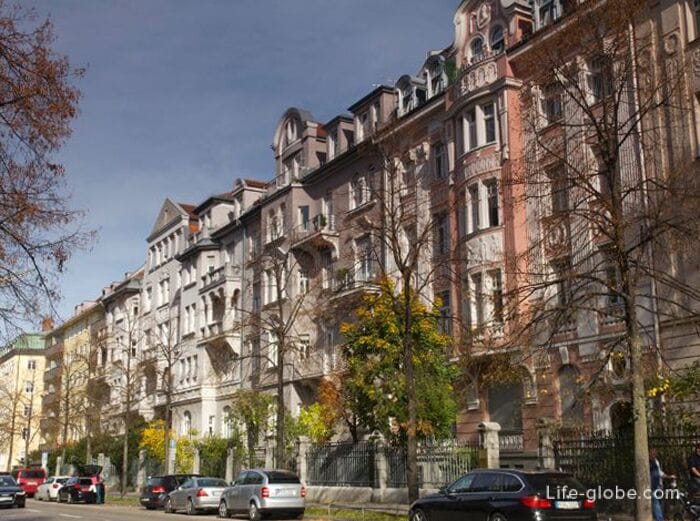
The center of the "old Bogenhausen" defines the old parish Church of St. George (Filialkirche St. Georg).
In 1357 the Church was included in the monastery of Freising. The Shrine is the mother Church for the whole area to the right of the ISAR. Because of the consecration of the parish Church of the Holy Blood in 1934, the Church of St. George lost its status as parish Church since the parish is a branch of the control of the Holy Blood.
Today, the Church of St. George is most known for its old small, where are buried many famous Bayern.
The address of the Church: Bogenhausen Kirchplatz 1 (Bogenhauser Kirchplatz).
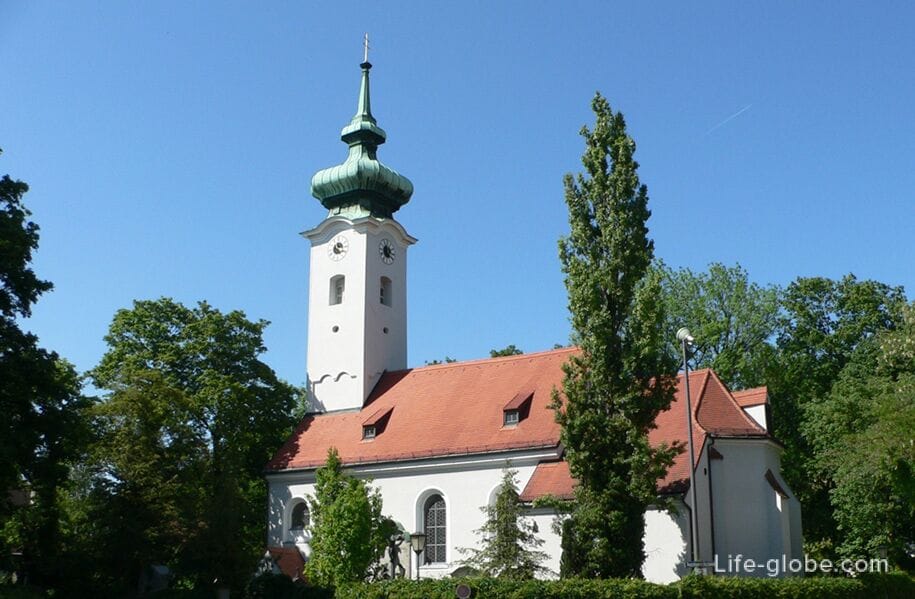
Catholic Church of the Holy Blood (Pfarramt Heilig Blut) was erected in 1934 by the architect Hans Doellgast. The construction of this Church was due to the fact that the population of the district Bogenhausen and grew existing at the time the Church of St. George was not enough space for parishioners.
During the Second world war the Church was badly damaged. Reconstruction was begun in 1950 and since then the Church has a wooden ceiling instead of the original ceiling plaster. Instead of the former pointed towers was built a new tower with a saddle roof, which was raised by the bell.
The Church is the body.
Near the Church there is a Playground. The address of the Church: Scheinerstrasse, 9 (Scheinerstraße).
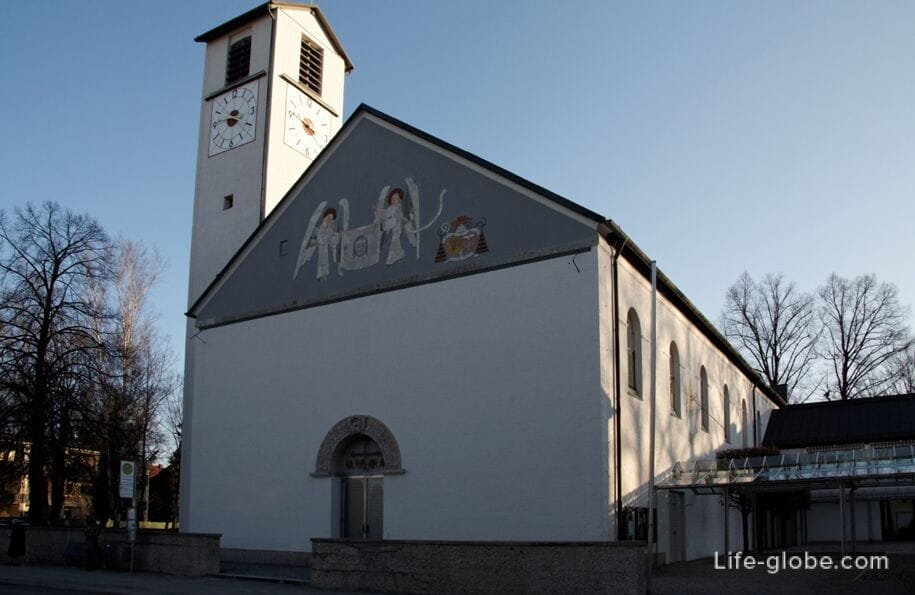
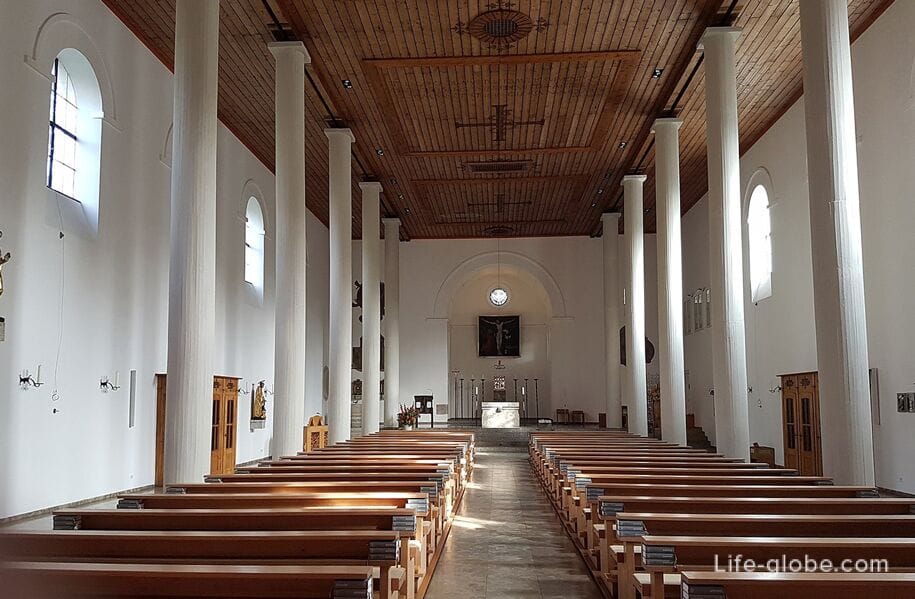
The building of the "Monacensia" - archive of literature on the city and research library for the history and cultural life of Munich.
Since 1898 the building was the former Villa of the sculptor, architect and painter Adolf von Hildebrand (1847-1921), was that he designed the Villa.
The Villa became the meeting place of the Munich society culture in the early 20th century and had a rich history until Monacensia moved into the building in 1977.
The property address: Maria-Theresien-straße, 23 (Maria-Theresia-Straße). The library's website: muenchner-stadtbibliothek.
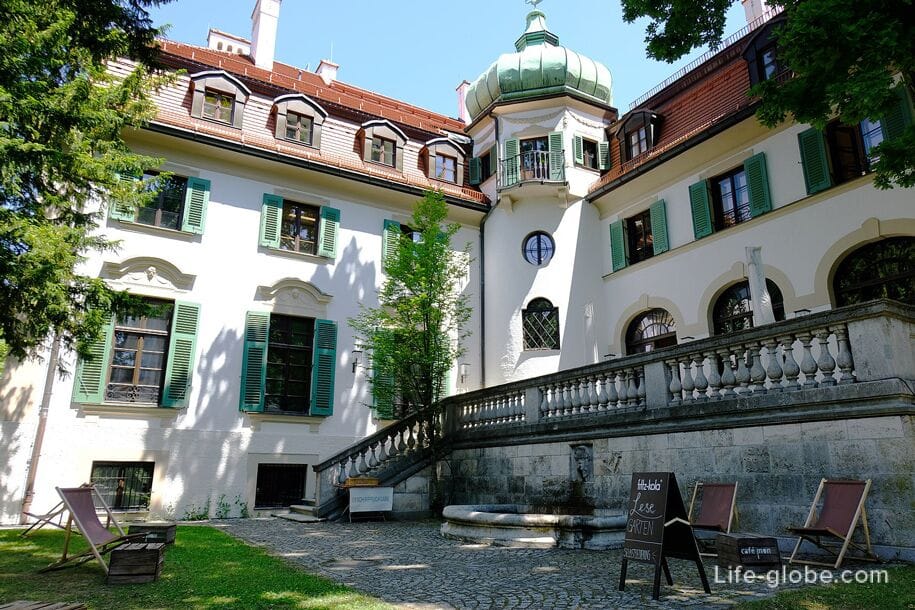
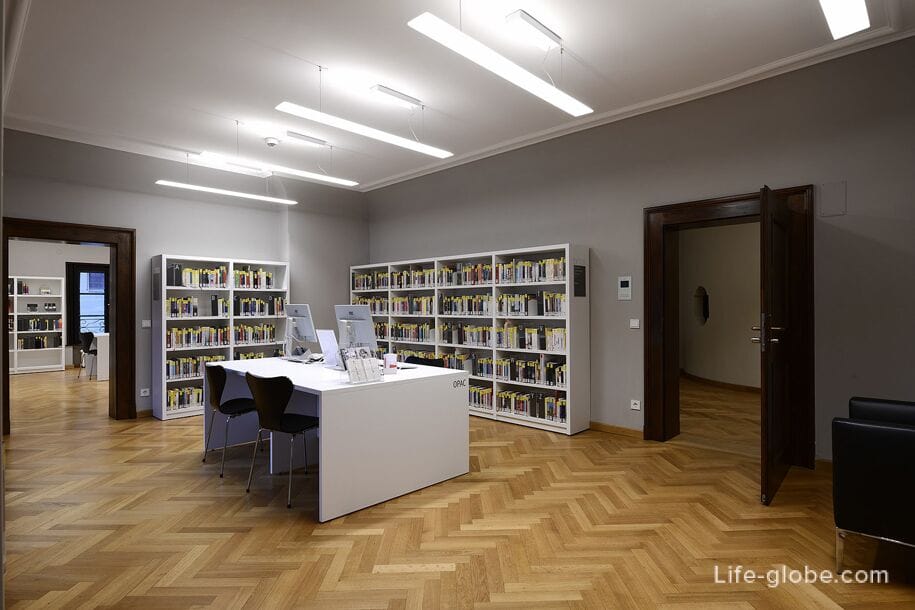
The main artery of the quarter is street Ismaninger straße, which stretches from South to North along almost the entire old Bogenhausen. Along the street are historical and architectural monuments, including the castle-like neo-Baroque building under the house number 109, which now houses the Federal fiscal court (Bundesfinanzhof).
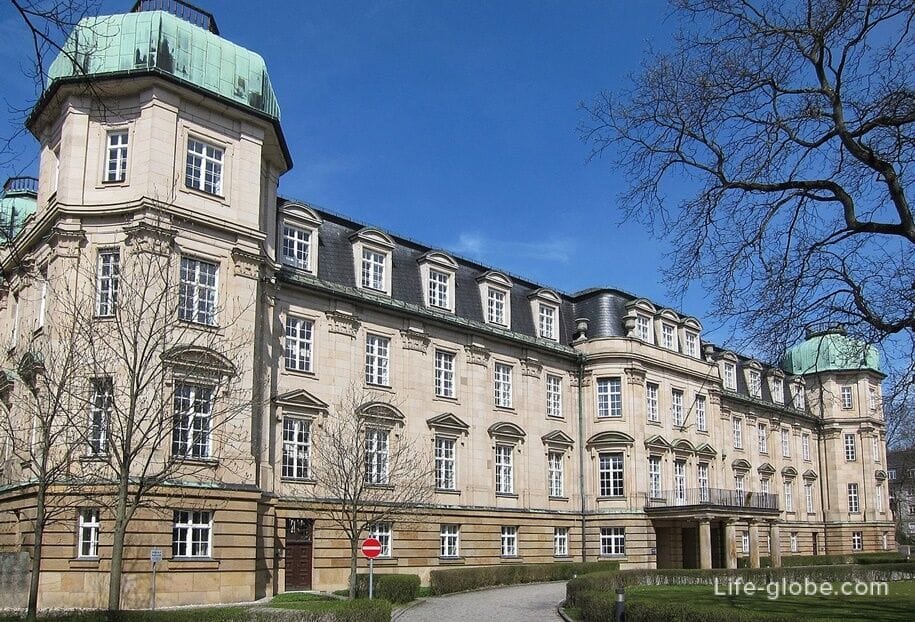
Prinzregentenstrasse
Prinzregentenstrasse (Prinzregentenstraße) is one of the main streets of Munich, which is one of the four Royal avenues of the city (urban boulevards).
It Prinzregentenstrasse forms the image of Bogenhausen in public opinion.
The Avenue was constructed from 1891, as the main street for the middle class, by order of the Prince Regent of Bavaria Luitpold, and named in his honor.
Prinzregentenstrasse stretches from North-Eastern outskirts of the historic old town of Munich in Eastern direction of the city to the junction with the street Einsteinstrasse (Einsteinstraße). In particular, the Eastern part of the street Prinzregentenstrasse (from the Luitpold bridge / Luitpoldbrücke) runs along the southern boundary of the district Bogenhausen, being the dividing line between the two areas: Bogenhausen and AU-Haidhausen.
A view of the bridge Luitpold from the district of Bogenhausen

Attractions along the street Prinzregentenstrasse
The memorial "angel of peace"
At the North-Western border of the area is a memorial to the angel of the world (Friedensengel / Friedensengel), dedicated to the 25th anniversary of the peace Treaty after the Franco-Prussian war of 1870-1871 years.
Peace monument consists of an open square temple, built in Greco-Ionian pattern, and high columns in the Corinthian style, which is decorated with a bronze figure of a Golden angel.
Near the column is open area - terrace Prinzregent-Luitpold (Prinzregent-Luitpold-Terrasse), with a panoramic view of the street Prinzregentenstrasse and part of the historic center of Munich. Read more about memorial angel of peace and observation...
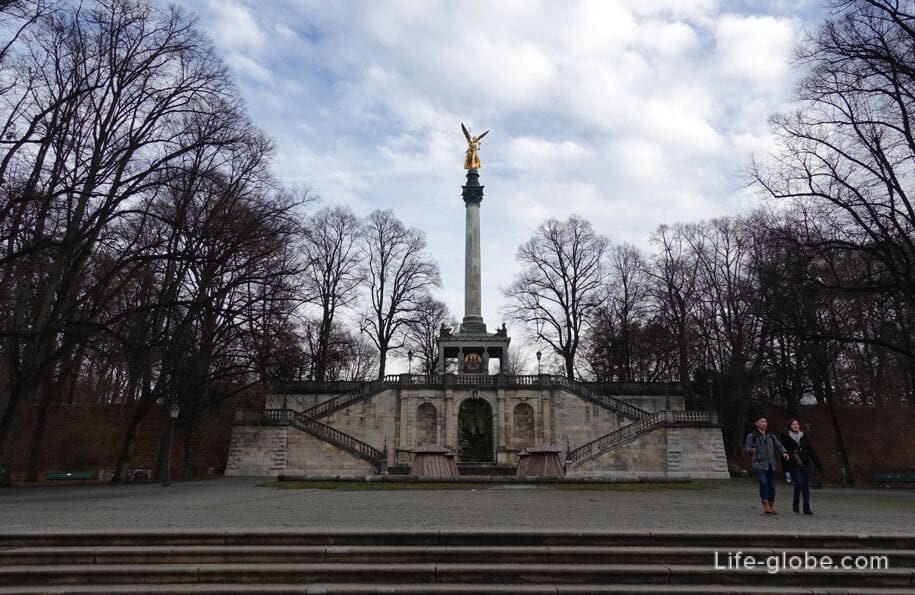
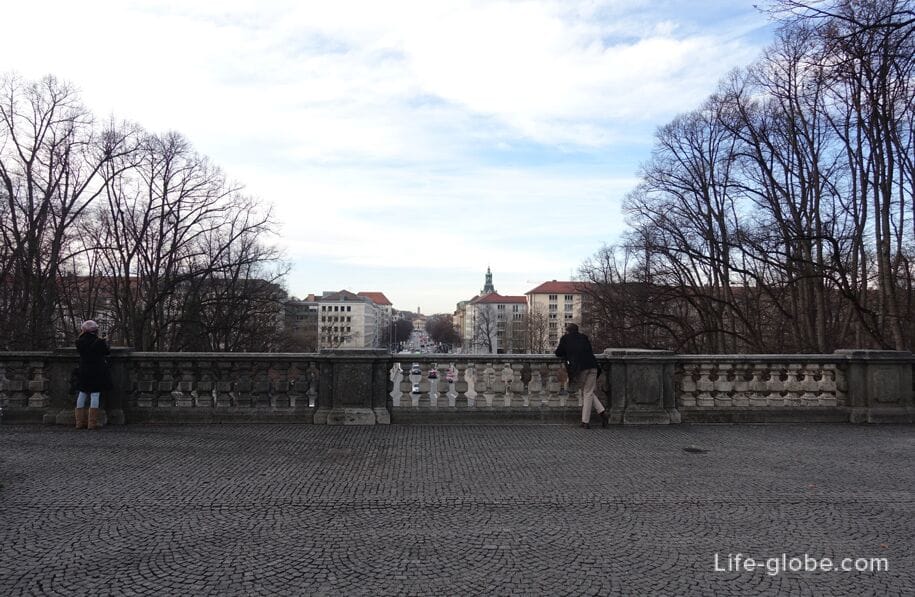
Villa Stuck
Villa stuck (Villa Stuck) - historic Villa, originally a private mansion, built in the years 1897-1898 in modern style to the German painter and sculptor Franz von stuck.
Since 1992, the walls of the Villa houses the Museum of Villa Thing, which presents stored historical room of the Villa with furniture, the artist's Studio, a collection of the works of Franz von stuck and exhibits of applied art of the 19-20 centuries.
Address of the Villa Thing: Prinzregentenstraße, 60. Read more about the Villa Stuck, and the Museum...
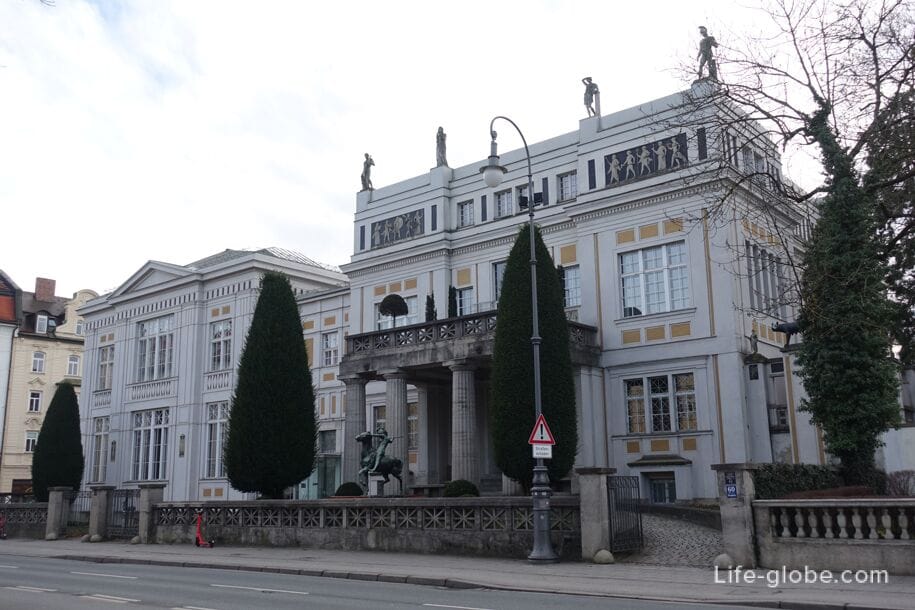
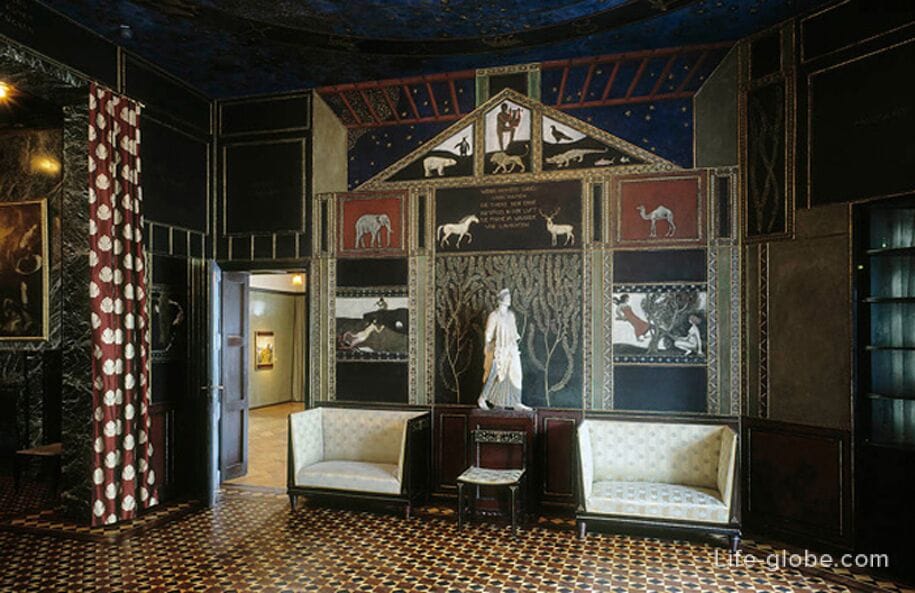
The theatre of the Prince Regent
The theatre of the Prince Regent (Prinzregententheater) was built of cast stone between 1900 and 1901 years by the architect max Littmann.
The theatre was opened on 21 August 1901 the Opera "the mastersingers of Nuremberg" (Die Meistersinger von Nürnberg) by Richard Wagner, which is considered one of the peaks of creativity of Wagner.
During the Second world war was destroyed a restaurant, the theatre was rebuilt in 1957-58, cropped on one axis.
The program of the theatre today includes performances of classical music, Opera and dance performances.
Address theatresquare Prinzregenten, 12 (Prinzregentenplatz). The website of the theatre: theaterakademie.
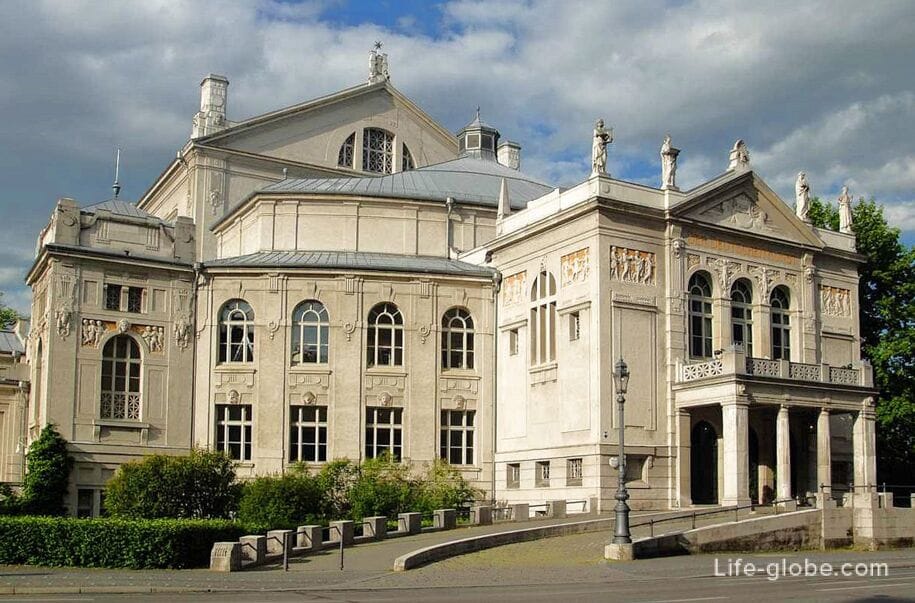
Besides theatre, the Prince Regent on the square Prinzregentenplatz remarkable houses of the gründerzeit, the fountain installed in the center of the square and a small square, which adorns the monument of the composer Richard Wagner (Richard-Wagner-Denkmal).
The house at number 16 on the square of the Prince Regent was the apartment of Adolf Hitler, now this building houses the police Department. Read more about the street Prinzregentenstrasse...
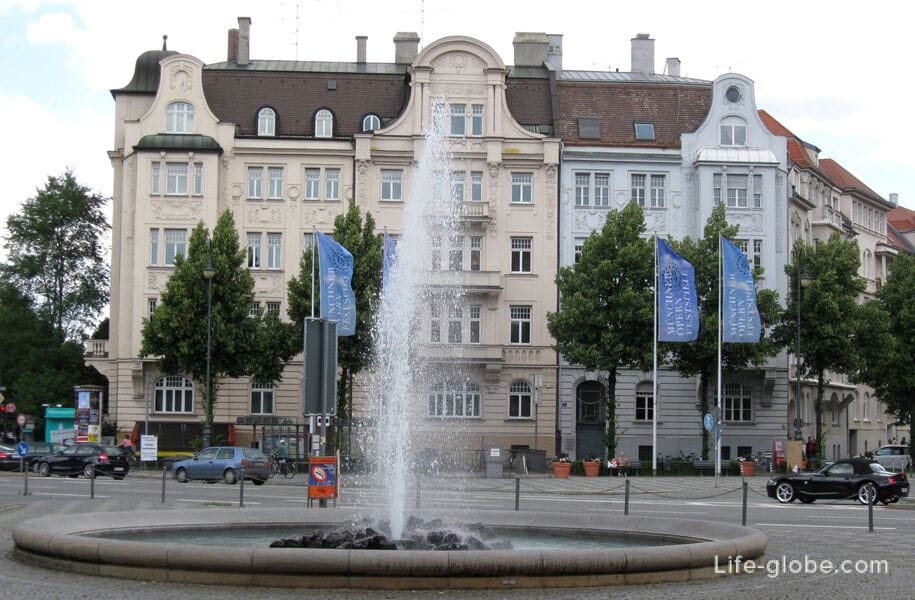
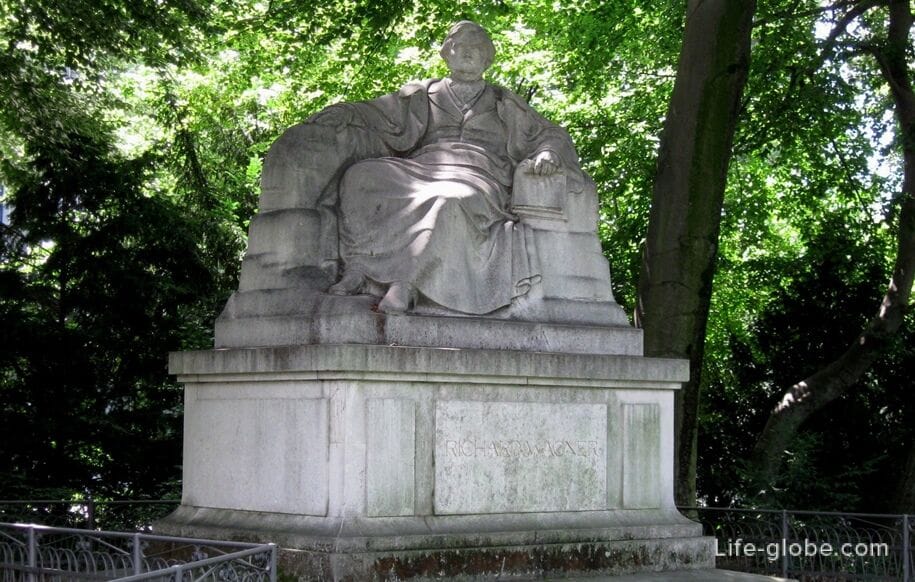
Sammlung Goetz
Goetz collection (Sammlung Goetz) is a private contemporary art collection which is represented in thematic temporary exhibitions in your own Museum building.
Sammlung Goetz was born when the German collector Ingvild Goetz has assembled a private art collection, with works starting from 1960-ies until present.
Today the collection consists of a range of contemporary art forms: paintings, graphics, drawings, photographs, video and film, projection and spatial installations.
Address of collection: Oberderdingen Strasse 103 (Oberföhringer Straße). Website collection: sammlung-goetz.

District Englschalking
District Englschalking has an historic centre and is located relatively Central in the district of Bogenhausen.
In the streets Stegmuller (Stegmühlstraße) and Embalmers (Rambaldistraße) during excavations carried out in 1983, it was discovered the burial of the late stone age and early bronze age burial ground. And on the Northern edge of Englschalking had excavated a settlement from the early middle ages with the house, well, barn, stables and the graves. Jewelry findings allow us to date the settlements in this area until the 7th century ad. Englschalking was founded in the 9th or 10th century.
Most modern buildings in the historic district date from the late 19th century, when Englschalking achieved some prosperity due to the cultivation of moss and brick factory where the bricks were made from clay and the lively construction activity in Munich.
The historic centre Englschalking is a good example of the village at that time. Some of the yards are located sporadically around the Church of St. Nicholas (St. Nikolaus), which dates from the 13th century and has an old cemetery. The center of the district, which is a monument of architecture, is about the same size as the village in the early 19th century.
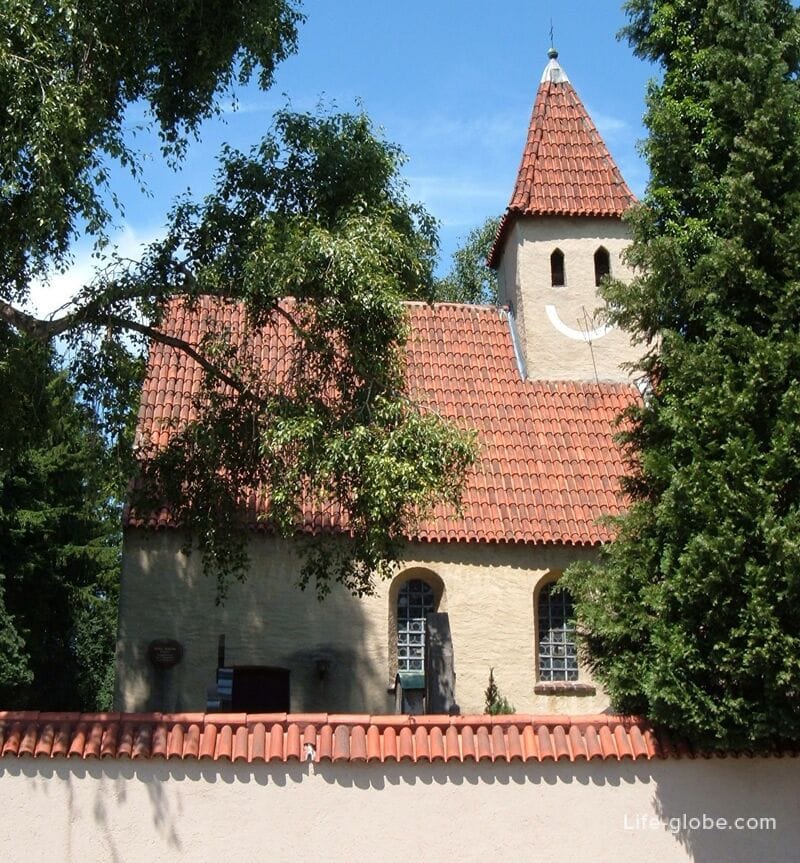
To the South of the district centre is Englishing primary school building on the street Ostpreussendamm (Ostpreussenstraße), the work of Herman Leitenstorfer from 1930-ies.
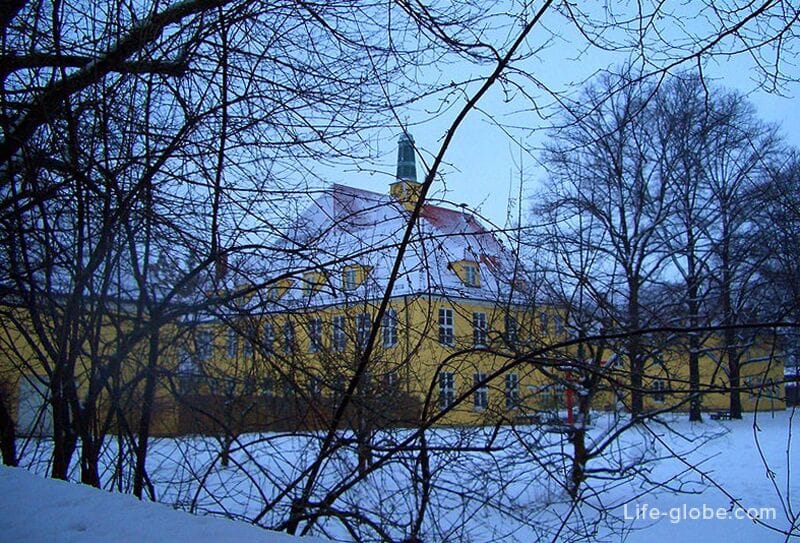
Modern quarters
Since 1957, in the Bogenhausen began to build the first major residential complexes with multi-storey buildings. In the next 30 years was built eight facilities - from exclusive and quiet, to the more simple and commercial, with some 15,000 housing units that have turned into neighborhoods with their own identity and infrastructure.


Attract attention:
- house of Hypo (Hypo-Haus) or the Tower of HVB (the HVB-Tower) - tall building that is the headquarters of Unicredit Bank AG, trading floor and data center.
The tower was erected in 1975. The skyscraper was officially opened on 16 November 1981.
The building has a height of 113.7 metres. The complex consists of towers with 27 aboveground and four underground floors and two low-rise buildings (North and South), connected with the tower.
The tower is located on the street Denninger straße (Straße Denninger);
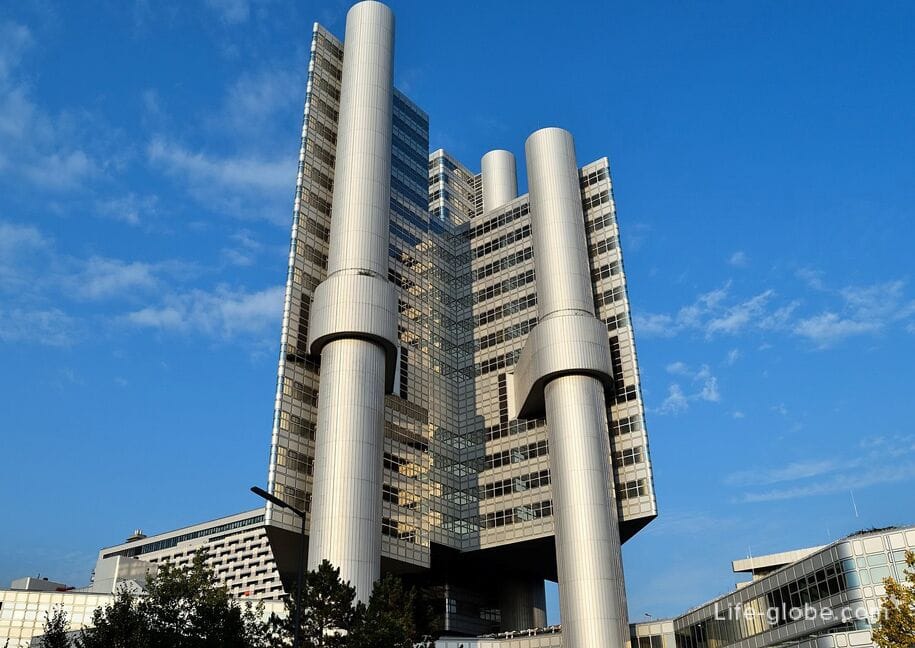
- the sculpture "Mae West" - art facility with a height of 52 meters, created by the American installation artist and sculptor Rita McBride, representing the core structure of the pipes in the form of a hyperboloid.
In the sculpture you can see (with great imagination) Hollywood star Mary Jane West in formfitting long dress.
The sculpture is located in Piazza Effnerplatz (Effnerplatz), which is a transport hub.

View of the tower HVB (right) and "Mae West" (center)
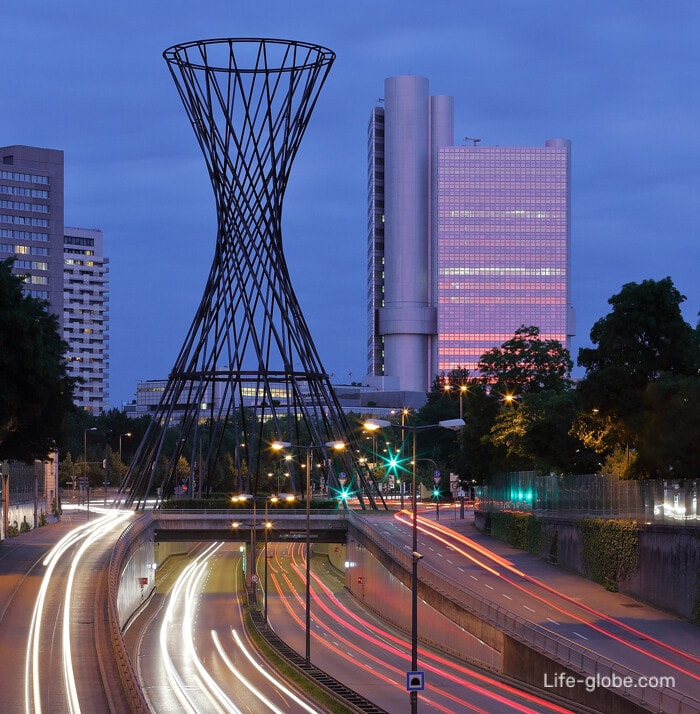
The ISAR River
The ISAR river flowing through the city of Munich in the direction from South to North, separates the district Bogenhausen from the Western side of the river.
The bridges across the Isar connects the East and West banks of the river.
In the South-Western part of the district of Munich, directly along the river ' Izrā is the Northern part of the Park Maximiliansanlagen (Maximiliansanlagen), which is one of the favorite places in the city for sports, walks and rest. Read more about the Park Maximiliansanlagen...
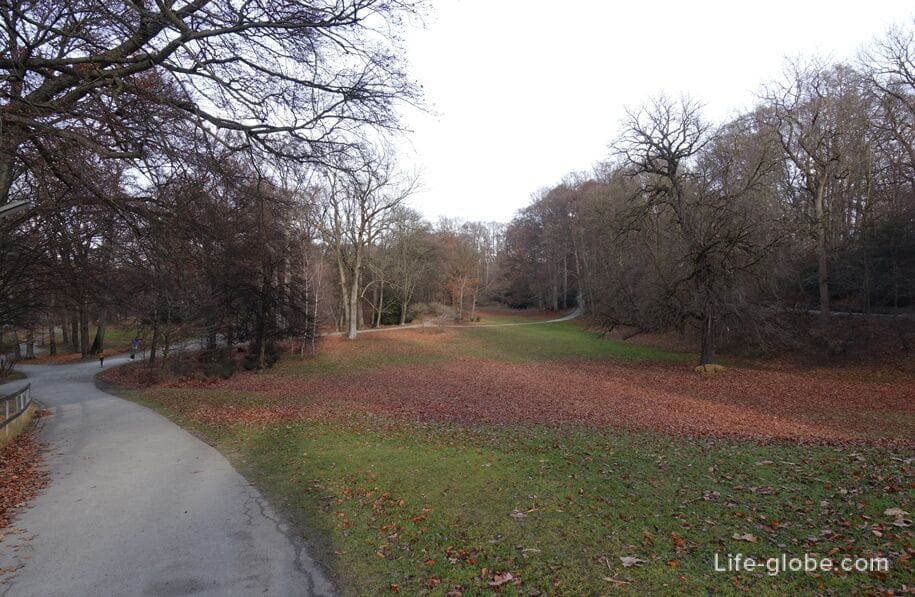
On warm summer days, the coast of izar is a popular spot for picnics and sunbathing. In fact, the ISAR you can swim. On the coast of the allocated BBQ areas.
Near Bogenhausen swimming opportunity is located 200 meters from the bridge of max Joseph (Max-Joseph-Brücke) and about 200 meters from the dam Overfiring (Stauwehr Oberföhring).
Several BBQ areas are located on the island part with the dam Overfiring. Read more about recreation on the river ISAR in Munich: swimming, barbeque, surfing, walking and...
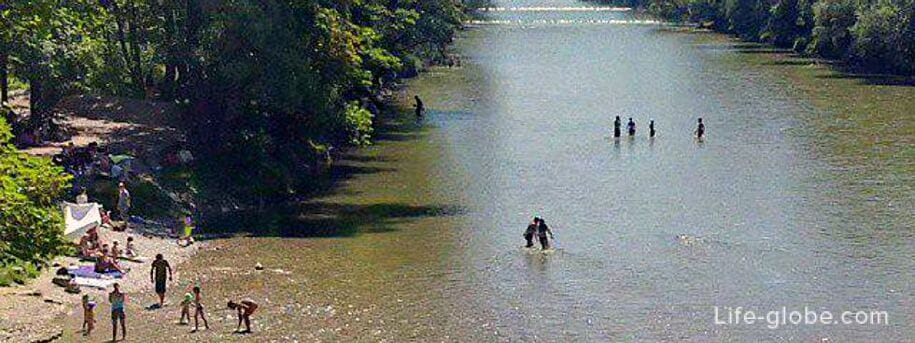
Pools, ice rink and Golf course in Bogenhausen
Pool "Cosima" (Cosimawellenbad), a total area of 120 sq. m., Munich is the only wave pool is 35 by 16 meters.
Pool features: tracks uncle swimmers, a volleyball pool, surfing area, trampoline, sauna, children's area and water slides, Jacuzzi and massage services. In the outdoor area there are places for sunbathing, warm swimming pool, children's pool and Playground.
Swimming pool address: Codemasters, 5 (Cosimastraße). Website pool: cosima-wellenbad.
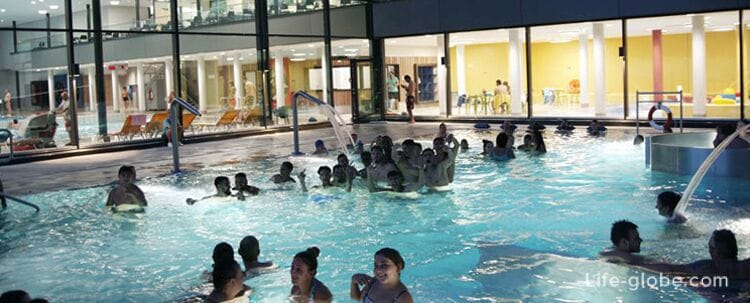
The pool located in the building of the stadium of the Prince Regent (Prinzregentenstadion), which features a sauna, steam bath, swimming pool, yoga Studio, Wellness center, Barber shop and restaurant "aquamarine" (Aquamarin Restaurant). Summer - outdoor pools, slides, lawn and children's Playground. Skating in winter.
Stadium address: Prinzregentenstraße, 80. Website: prinzregentenstadion.
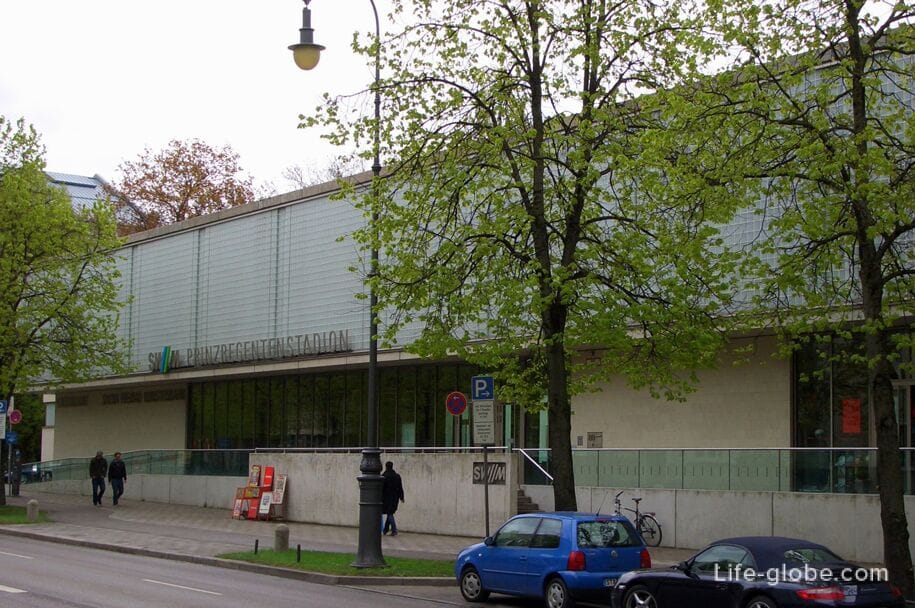
Near Bogenhausen, Western and North-Western sides, are the Golf courses: Golf club "Munich-Rome" (München Riem GmbH & Co.KG), Golf Park "Aschheim" (Golfpark München Aschheim GmbH & Co. KG) and Golf Park Green hill (GREEN HILL - The Golf & Event Park Inn Munich-East).
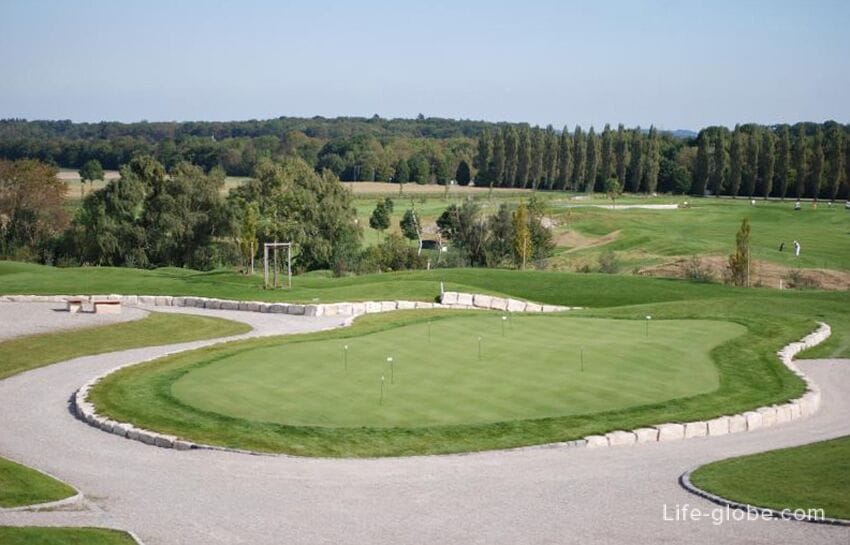
The location of the district Bogenhausen
The district Bogenhausen stretches on the Eastern side of the ISAR river, to the borders of the city of Munich from the North and North-East sides; the South-East the district borders with the district of Trudering-Riem (Trudering-Riem); to the South with the districts of Berg am Laim (Berg am Laim) and AU-Haidhausen .
The district of Bogenhausen on the map

Where to stay in the district of Bogenhausen
5 star hotel München Palace, located almost on the border of the districts of Munich and AU-Haidhausen, near the memorial "angel of peace".
In hotel: restaurant, bar, sauna, steam room, fitness room, free Wi-Fi and Parking.
In the rooms: parquet floors, a free Minibar, a flat-screen TV and a marble bathroom.
Room rates may include Breakfast. Link to the hotel

The Hyperion hotel München features a restaurant, bar, gym, tour Desk, free Wi-Fi, Parking and rooms for conferences.
In rooms: air conditioning, sports Sky channels, tea/coffee facilities, a design armchair, a Desk, a safety Deposit box and bathroom with rain shower and Underfloor heating.
The hotel has rooms with panoramic views of the city.
Room rates may include Breakfast. Link to the hotel

The 5-star Westin Grand Munich has 2 restaurants, tavern with beer garden, bar, Parking and Spa centre with gym and indoor swimming pool.
From the hotel Windows offer views of the city.
In the rooms: a living area with a flat-screen TV, a marble bathroom with a rain shower. Bathrobes and toiletries.
Room rates can be inclusive of the Breakfast buffet. Link to the hotel
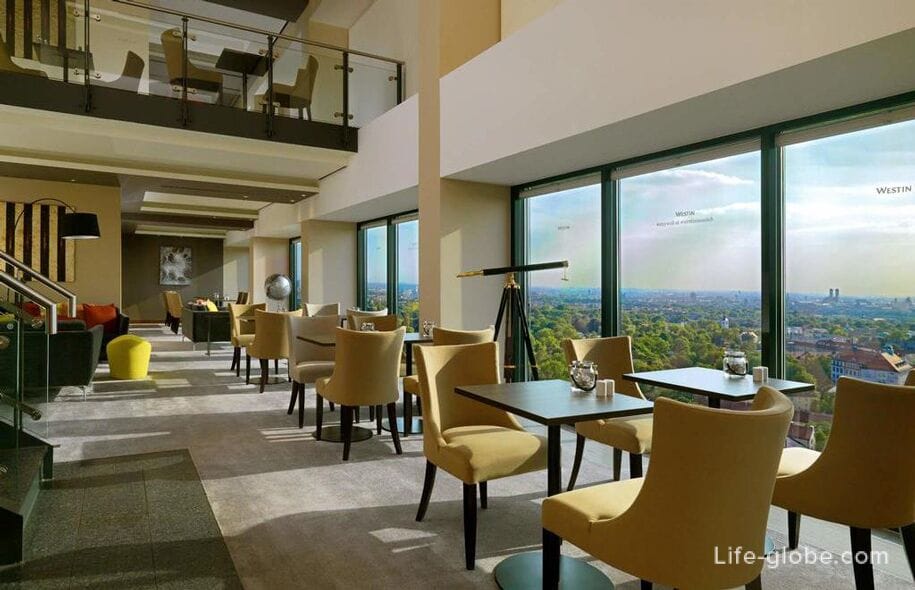
The 4-star Sheraton Munich Arabellapark hotel features 2 restaurants with a bar and beer garden, a lounge with free use of computers and printer, Parking, Spa on the 23rd floor with a heated pool, gym, sauna and steam room.
In rooms: air conditioning, flat-screen TV, tea/coffee making facilities and large Windows. Some rooms have a balcony.
Room rates may include Breakfast. Link to the hotel
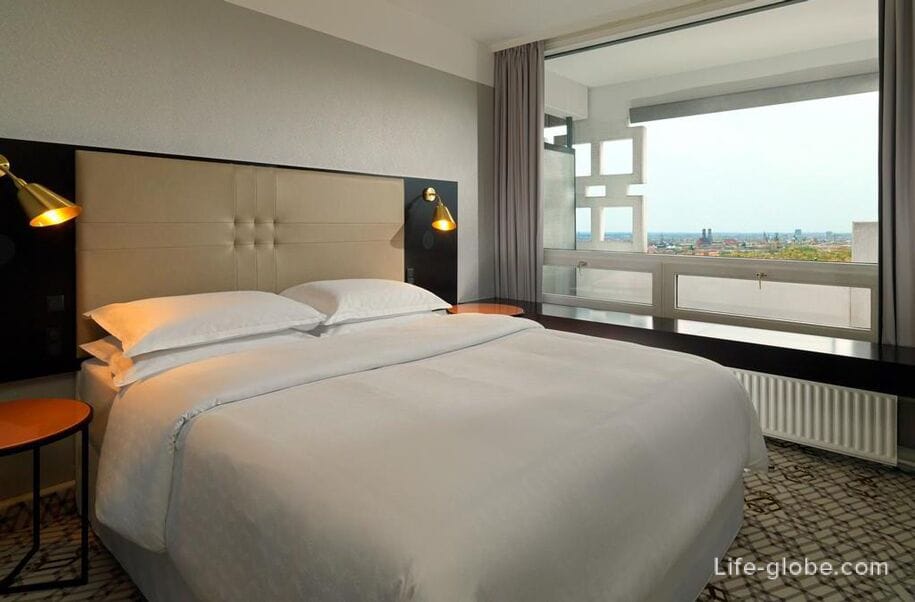
The 4-star Parkhotel Rothof with restaurant, bar, lounge, garden, gym and Parking.
In the rooms: free Wi-Fi and a flat-screen TV. Link to the hotel

All accommodation in Munich, including in the area of Munich and in the city centre, you can view and book here




